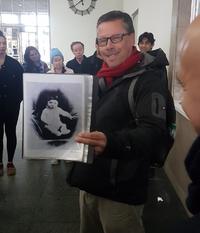Photo. My tour guide Jeff, tour operator Viator (Viator.com), showed me a photo of a "cute little boy" from circa 1889. His name was Adolf Hitler, Adolf Hitler was born on 20 April 1889 in the small Austrian town of Braunau am Inn, in Upper Austria on the Austrian-German border.
Because of Munich importance to the rise of Nazism, the Nazis called the city the Hauptstadt der Bewegung, "Capital of the Movement". Munich synonymous with some of the dramatic events of the 20th century, the birth of Nazism, the British, French and Italian appeasement of Hitler in 1938, the massacre of 11 Israeli athletes by Palestinian terrorists at the 1972 Olympics. In 1919 Hitler gave his first public political speech in Hofbräukeller.
On my tour I could dive into Munich’s dark past and the birth of the Nazi ideology. I got insight in the rise of Adolf Hitler and the Nazis in the 1920s and 1930s, considered from the Germans point of view. It was interesting to see streets and buildings where Hitler fought his way to power and gave speeches. I visited the beer-halls where Nazi fanatics gathered and sites linked to the 1938 anti-Semitic pogrom of Kristallnacht. I visited memorials to those who died opposing the hate-filled Nazi ideology. It was frightening to hear about the Nazi propaganda machine and what lead-up to World War II from the very knowledgeable guide guide. He knew the history and could tell it chronologial in a very convincing way.
The Holocaust is the greatest crime in history, one that people remain desperate to understand. The birthplace of the Nazi Party, Munich still has numerous sites. Because of its importance to the rise of Nazism, the Nazis called Munich the Hauptstadt der Bewegung ("Capital of the Movement").
- Hitler’s Beer Halls
- Königsplatz: Nazi Party Buildings
- 16 Prinzregentenplatz: Hitler’s Address
- Old Town Hall
- Haus der Kunst – the House of Art
- Outside of Town: Dachau Concentration Camp (was not a part of this tour, and read more in another article on this website)
Founding the Third Reich, giving Munich its title as the "Capital of the Nazi Movement". Adolf Hitler promised his people to raise a great German empire with prosperity and welfare, but it all ended up in a huge catastrophe. He becomes the most destructive politician of the 20th century. 50 million people died during the Second World War, and 6 millions …….
See the beer-halls where Nazi brown shirts first gathered, buildings from where Hitler delivered speeches, and memorials to opposers of the movement, all as your guide charts the events that saw Hitler take power in 1933. The Hofbräuhaus am Platzl is a popular beer hall in Munich, Germany. In 1919, the Munich Communist government set up headquarters in the beer hall, and in February 1920 Adolf Hitler and the National Socialists held their first meeting in the Festsaal, the Festival Room, on the third floor (see photo). Here the alcohol floated and strengthened their misguided opinions. You can still visit this beer hall today, which has a friendly atmosphere you wouldn’t typically associate with a dictator.
The Beer Hall Putsch was Hitler’s attempt to overthrow the German government and establish nationalist rule. On 9 November 1923 he marched on Munich with 3,000 supporters; met by army and police, 16 Nazis and four policemen died in the ensuing gunfight. After a sensational trial, Hitler was sentenced to five years for treason, serving nine months.
Munich suffered extensive damage during World War II—Allied air raids struck the city 71 times. After the war, it was meticulously rebuilt to look as much as possible as it did before 1940. In recent years, Munich has consistently been rated among the world’s most livable cities, thanks to its seamless blending of the modern with the medieval, the spaciousness of its public gardens and avenues, its standing as Germany’s most prosperous city, its world-class cultural attractions, its superb public transportation and its manageable population of 1.3 million. Munich is one of those rare major cities that feel cozy. Germans call it "Millionendorf"—"village of a million people."
Stein Morten Lund, 1st November 2018
Additional information
Read more about Munich in Smithsonian magazine: https://www.smithsonianmag.com/travel/munich-at-850-84396578/
The Rise of Adolf Hitler, By Jeremy Noakes, Last updated 2011-03-30, BBC
http://www.bbc.co.uk/history/worldwars/wwtwo/hitler_01.shtml












